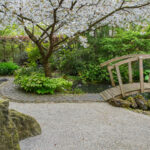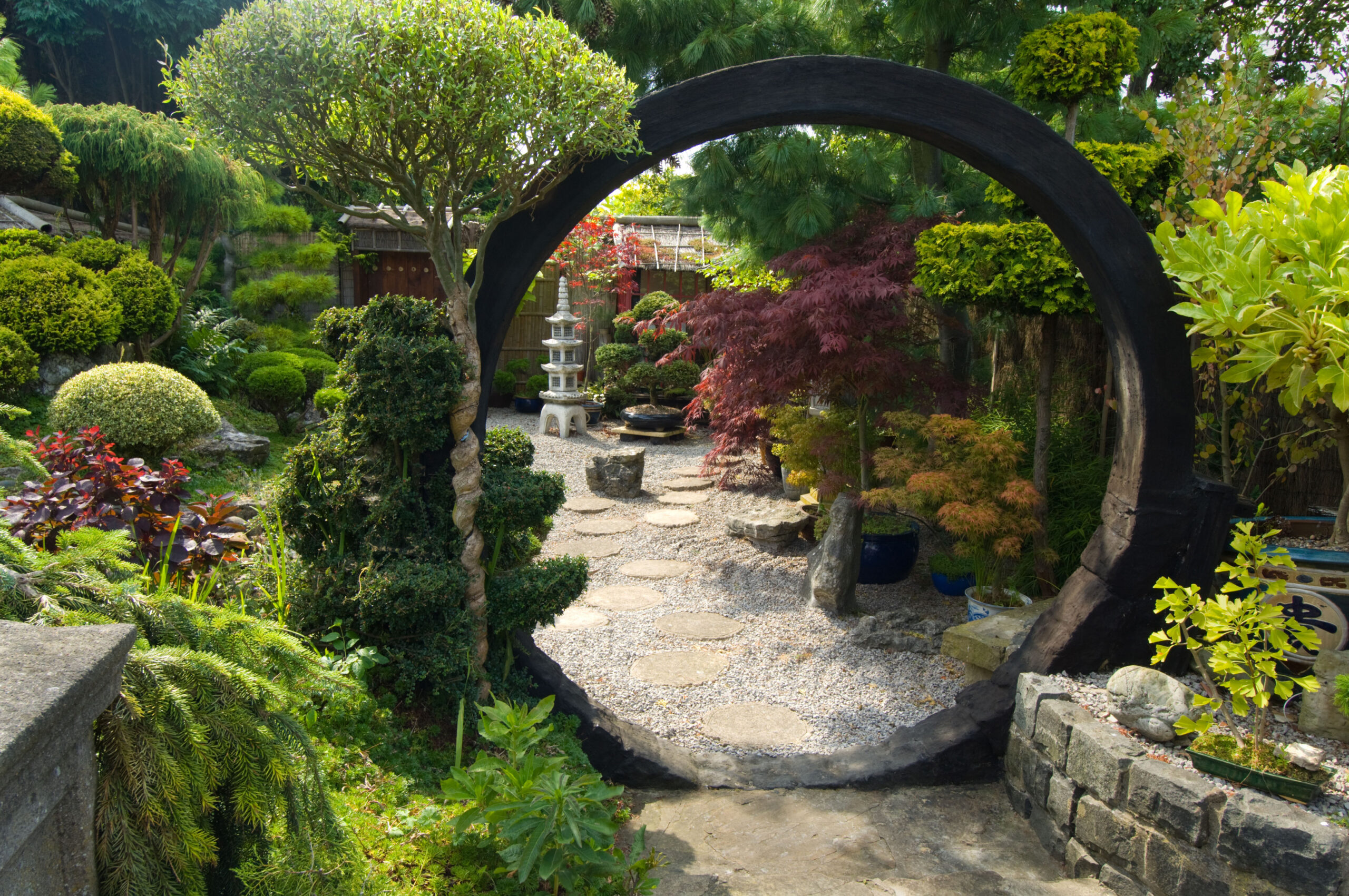Embarking on the journey to create a Japanese garden can transform your outdoor space into a serene sanctuary. These gardens are an embodiment of tranquility and minimalist beauty, inviting peace into any landscape.
Inspired by centuries-old traditions, Japanese garden designs offer a timeless aesthetic that harmonizes with nature. Regardless of the size of your space, these gardens can be tailored to foster a sense of calm and mindfulness.
What is a Japanese garden?
The essence of a Japanese garden lies in its ability to capture the natural landscape in a more intimate and stylized manner. It’s designed to reflect the philosophical ideas of simplicity, balance, and harmony with nature.
Such gardens often feature elements like stones, water, and plants, each representing philosophical ideas such as strength, fluidity, and growth. A Japanese garden is a place where one can meditate and enjoy the changing seasons.
Intricate pruning techniques and carefully selected flora create a miniature version of nature, emphasizing the beauty found in asymmetry and the impermanence of life.
How to create a Japanese style garden space?
Creating a Japanese style garden requires a thoughtful approach to design. Begin by planning your space, considering how each element will contribute to a sense of tranquility.
Focus on incorporating natural materials like stone and wood, and consider the use of gravel or sand to represent water. The placement of these elements should be intentional, guiding the eye and the footsteps.
Introduce plants that offer varied textures and colors, yet maintain the overall minimalist aesthetic. Remember, a Japanese garden should feel like a natural landscape, not overly manicured.
Consider the inclusion of a tea house or pavilion as a focal point, offering a space for reflection and enjoyment of the garden’s beauty.

Lastly, incorporate subtle lighting to enhance the atmosphere during the evening hours, allowing the garden to be enjoyed at any time of day.
What materials should you use in a Japanese garden?
Selecting the right materials is crucial to create an authentic Japanese garden. Natural, unobtrusive materials that blend with the surroundings are preferred.
Stones and gravel are commonly used for paths and to represent water, while bamboo and wood can be incorporated for fences and bridges.
When choosing plants, opt for species like Japanese maples and azaleas, which offer seasonal color and traditional appeal.
Grasses and mosses add texture and help to create a contemplative experience, simulating the forest floor.
The use of water, whether it be a pond, stream, or simple basin, adds a dynamic and reflective quality to the garden.
Can Japanese style gardens be designed for small gardens?
Even small spaces can embrace the beauty of a Japanese garden. The key is to focus on simplicity and the careful selection of features that convey a larger landscape.
Small trees like bonsai or dwarf varieties can give the impression of age and grandeur without overwhelming the space.
Rock arrangements and a small water feature, such as a bamboo fountain, can suggest the presence of a natural stream or pond.

Use vertical space by training plants to grow upward on trellises or walls, adding depth and interest.
Mirrors can be cleverly placed to give the illusion of a larger garden and to reflect key elements.
By choosing a few key elements and keeping the design uncluttered, even the smallest garden can capture the spirit of a Japanese landscape.
Japanese garden ideas for small spaces on a budget
- Utilize potted plants like bonsai for easy and affordable greenery.
- Opt for a simple Zen rock garden, which requires minimal materials.
- Repurpose items such as old basins or bowls to create water features.
- Use gravel and stones for low-cost ground cover that requires little maintenance.
- Seek out local sources for materials to save on transportation costs.
Modern Japanese garden ideas: How to achieve a contemporary feel?
Modern Japanese gardens blend traditional elements with contemporary design, creating spaces that feel both timeless and current. Focus on clean lines and minimalist features.
 Zen garden ideas: 11 ways to create a calming, Japanese-inspired landscape
Zen garden ideas: 11 ways to create a calming, Japanese-inspired landscapeConsider using materials like polished concrete or metal for a modern twist on pathways and lanterns. These can add to the garden’s aesthetic without detracting from the natural feel.
Introduce modern art sculptures that complement the garden’s theme, serving as contemporary interpretations of classic elements like stones or trees.
Experiment with lighting, using LED lights to accentuate plants and water features, offering a more current ambiance.
Employ a restrained color palette, favoring greens, whites, and grays to maintain a modern and tranquil atmosphere.
What color palette should you focus on in a Japanese garden?
The color palette of a Japanese garden typically revolves around natural, muted tones that evoke calmness and tranquility. Greens, grays, and browns dominate, reflecting the colors of the natural world.

Seasonal blooms can introduce subtle splashes of color without overwhelming the senses, maintaining the garden’s peaceful atmosphere.
Consider the use of evergreens for year-round color and structure, complemented by the seasonal changes of deciduous plants.
For a harmonious palette, focus on the natural colors of the materials used, such as the grays of stone and the warm tones of wood.
Remember, a Japanese garden is an exercise in restraint, so any use of color should be thoughtful and deliberate.
Related Questions on Japanese Garden Ideas
What is a Japanese garden?
A Japanese garden is a stylized landscape that uses traditional elements like stones, water, and plants to create a serene and meditative environment. It is grounded in principles of simplicity, nature, and the miniature representation of natural beauty.
Such gardens are designed to provide a space for reflection and to express the natural world in an artistic way, often drawing on Shinto, Buddhist, and Taoist philosophies.
How to create a Japanese style garden space?
To create a Japanese style garden space, begin with a clear design plan that emphasizes natural beauty and serenity. Use elements such as rocks, ponds, and carefully curated plants to construct a cohesive and tranquil environment.
Pay special attention to the balance and flow between elements, ensuring that the garden feels like a natural ecosystem rather than a constructed space.
What materials should you use in a Japanese garden?
Materials in a Japanese garden should be natural and blend harmoniously with the surroundings. Stones, bamboo, wood, and gravel are traditionally used to create pathways, water features, and focal points within the garden.

Plants should be chosen for their aesthetic qualities as well as their ability to thrive in the specific climate of the garden’s location.
Can Japanese style gardens be designed for small gardens?
Absolutely, Japanese style gardens can be adapted to small spaces by selecting appropriate miniature or dwarf plants and by using design techniques that create the illusion of depth and space.
Rock gardens and water features can be downscaled, and vertical elements can be introduced to maximize the use of limited space.
What color palette should you focus on in a Japanese garden?
In a Japanese garden, the color palette should be calming and cohesive. Greens, browns, and grays are the core colors, with seasonal flowers providing gentle accents. The aim is to reflect the subdued hues found in the natural landscape.
Choose plants and materials that offer subtle variations in color, ensuring that they complement each other and contribute to the overall sense of harmony.
As we delve into the world of Japanese garden ideas, let’s take inspiration from this insightful video on how to create a tranquil space using landscaping and plants.
Whether you have a sprawling yard or a modest balcony, Japanese garden ideas for small spaces can help you introduce a touch of Zen to your life. A well-designed Japanese garden speaks to the soul, providing a space for peaceful contemplation and a retreat from the busy world outside.
 Patio decor ideas: 16 ways to enhance your outdoor space
Patio decor ideas: 16 ways to enhance your outdoor space
